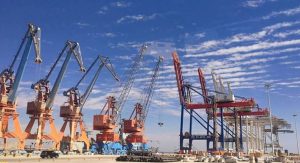Last month, Samoa’s expected new prime minister, Fiame Naomi Mata’afa, pledged to cancel the $100 million Chinese-backed port development project in Vaiusu Bay. She expressed concerns over the Samoan government’s growing indebtedness to China and called the development project “excessive.” During a regular press conference, Chinese Foreign Ministry spokesperson Zhao Lijian commented that China is working with the Samoan government to assess the feasibility of the project and stressed that China aims to “provide assistance to the best of its ability with no political strings attached.”
Zhao’s statement is part of an effort by China to counter the growing narrative that its role in commercial port projects provides cover for other ambitions. Observers of China’s port acquisitions point to the country’s national strategy of military-civil fusion and how commercial capacity at ports may be leveraged for military means. Although China’s increasing investment in foreign seaports has legitimate implications for the future of Chinese military power projection, the timeline for getting a commercial port to an operational level sufficient for use by the People’s Liberation Army Navy (PLAN) is quite drawn out, as China has only begun to lay the groundwork for this kind of dual-purpose use.
In February 2020, Isaac Kardon testified before the U.S.-China Economic and Security Review Commission and discussed the implications of the 2016 rollout of the National Defense Transportation Law. The law obligates organizations such as state-owned enterprises (SOEs) to support the State Council and Central Military Commission in the defense of national interests abroad and stipulates that overseas infrastructure projects must be designed to meet military standards. Commercial ports owned and/or operated by Chinese SOEs could thus conceivably be used to support the military’s long-range projection capabilities. While this law lends legitimacy to the idea of potential PLAN deployments to overseas ports in the future, the establishment of a sophisticated network of commercial ports as key logistic nodes for the PLA’s future expeditionary operations is still only a distant prospect. The infrastructural capacity needed for naval access points is far from being realized in many of these ports.
The port of Gwadar in Pakistan is illustrative of the present-day constraints that China faces in its purported effort to project force via control of commercial ports. The port officially became the flagship project of the China-Pakistan Economic Corridor (CPEC) in 2015 and was handed to the China Overseas Port Holding Company (COPHC) for a 40-year lease in 2017. Under the terms of the agreement, COPHC would handle the operations and carry out all the development work on the port throughout the duration of the lease. China has said that the port of Gwadar is purely a commercial venture with no military overtones and Pakistan has reiterated the same, sustaining the narrative that the port is intended to be a transshipment hub that will facilitate economic activity in the region. However, given the operational and developmental control that COPHC has over the port, the port could be developed — in accordance with the National Defense Transportation Law — in a way that supports China’s efforts to create strategic strongpoints, or ports with both strategic and commercial value.
Despite the conditions that have been created for an integrated civil-military approach, the port of Gwadar is nevertheless still in its groundwork stage and observers should not expect to see a near-term utilization of the port as an access point for the PLAN. As it stands, the Gwadar Port Authority — the agency responsible for certain project initiatives at the port — is still in the preparation stage of creating additional terminals along the Gwadar East Bay and constructing the infrastructure needed for larger vessels.
In addition to the infrastructural limitations that many ports still face, the use of commercial ports for non-war types of military operations is subject to the relationship that Beijing has with the host country. The overall health of the broader economic, political, and security relationship is a prerequisite to the successful implementation of ports with dual-use capability. The arrangement requires tact and diplomacy, and it is in the interest of Beijing to nurture the development of commercial ports in a prudent manner, to both preserve its relationship with the host country and to avoid unwanted attention from the international community.
A scholar with the PLA Academy of Military Science highlighted this as a key issue in the process of building strategic strongpoints, stressing the point that “military diplomacy should not be overemphasized in the process of building a strategic [strongpoint].” On the speed of implementation, she wrote, “When advancing military diplomacy, we should pay attention to the method and rhythm. We should not push forward forcibly and be eager to achieve results. Instead, we should negotiate with the target country and make progress gradually.” The scholar continued on to say that “almost every action of China overseas will attract the attention of other big countries” and “such attention may escalate into competition and resistance.” Accordingly, observers should not expect to see the rapid execution of a network of strategic strongpoints in the near future, but rather a prolonged and cautious implementation in order to evade scrutiny and pushback.
China’s increasing control over foreign ports via development and acquisition agreements paints a foreboding picture, in which China substantially strengthens its overseas operational logistics capabilities to service its military and force projection needs. However, there are a number of intermediate steps between the acquisition of ports and the systematized use of ports as dual-use facilities. Beijing is only in the preparatory stages of creating the architecture required to meaningfully exploit the military capabilities of commercial ports. The protracted timeline for a full-scale implementation of such an effort offers other global powers the opportunity to call attention to, and to possibly constrain, China’s growing military reach.

































